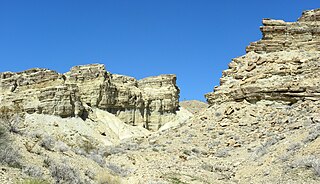
Branchiopoda is a class of crustaceans. It comprises fairy shrimp, clam shrimp, Diplostraca, Notostraca, the Devonian Lepidocaris and possibly the Cambrian Rehbachiella. They are mostly small, freshwater animals that feed on plankton and detritus.

Anostraca is one of the four orders of crustaceans in the class Branchiopoda; its members are referred to as fairy shrimp. They live in vernal pools and hypersaline lakes across the world, and they have even been found in deserts, ice-covered mountain lakes, and Antarctic ice. They are usually 6–25 mm (0.24–0.98 in) long. Most species have 20 body segments, bearing 11 pairs of leaf-like phyllopodia, and the body lacks a carapace. They swim "upside-down" and feed by filtering organic particles from the water or by scraping algae from surfaces, with the exception of Branchinecta gigas, or "giant fairy shrimp", which is itself a predator of other species of anostracans. They are an important food for many birds and fish, and some are cultured and harvested for use as fish food. There are 300 species spread across 8 families.
The midvalley fairy shrimp, Branchinecta mesovallensis, is a small freshwater crustacean in the Branchinectidae family. The midvalley fairy shrimp was only recently formally described as a species in 2000 by Belk and Fugate. Midvalley fairy shrimp are endemic to shallow ephemeral pools near the middle of California's Central Valley. These vernal pool ecosystems are home to other unique organisms adapted to the ephemeral nature of the water cycle in the pools in California's mediterranean climate.
Branchinecta belki is a species of fairy shrimp in the family Branchinectidae. It is found in Central America.

Branchinecta is a genus of fairy shrimp in family Branchinectidae. It includes around 50 species, found on all continents except Australia. Branchinecta gigas, the giant fairy shrimp, is the largest species in the order, with a length of up to 10 centimetres (4 in), and Branchinecta brushi lives at the highest altitude of any crustacean, at 5,930 metres (19,460 ft), a record it shares with the copepod Boeckella palustris. A new genus, Archaebranchinecta was established in 2011 for two species previously placed in Branchinecta.

Branchinecta sandiegonensis is a rare species of crustacean in the family Branchinectidae and the order Anostraca, the fairy shrimp. Commonly known as the San Diego fairy shrimp, it is named after the vernal pools found in San Diego County, California, where this species was originally discovered. It is also a federally listed endangered species of the United States.

Branchinella is a genus of crustaceans in the family Thamnocephalidae. This fairy shrimp genus is found across many parts of the world, but especially western Australia and southern Africa.

Branchinectidae is a family in the order Anostraca, containing two genera – Branchinecta and Archaebranchinecta. The majority of the species are in the genus Branchinecta, with only Archaebranchinecta pollicifera and the fossil Archaebranchinecta barstowensis in the second genus.
Branchinecta gigas is a species of fairy shrimp that lives in western Canada and the United States. It is the largest species of fairy shrimp, growing up to 86 mm (3.4 in) long. It is known commonly as the giant fairy shrimp.

The Barstow Formation is a series of limestones, conglomerates, sandstones, siltstones and shales exposed in the Mojave Desert near Barstow in San Bernardino County, California.

Tanymastix stagnalis is a species of Anostraca that lives in temporary pools across Europe. It may reach up to 2 cm (0.8 in) in some areas and has 11 pairs of bristly, flattened appendages. It swims upside-down and filters food particles from the water. It is the only species of Anostraca in Ireland, having been discovered in Rahasane Turlough in 1974.

Archaebranchinecta barstowensis is a species of fairy shrimp (Anostraca) that inhabited California during the Middle Miocene. Its fecal material is abundant in the concretions from the Barstow Formation. A limited number of whole specimens have been found, and they represent the "best-preserved fossil anostracan known to date". The closest relative of A. barstowensis appears to be Archaebranchinecta pollicifera from the surroundings of Lake Titicaca, and the two have been separated from the genus Branchinecta as the new genus Archaebranchinecta.
Branchinecta brushi is a species of fairy shrimp found at an altitude of 5,930 m (19,460 ft) in the Chilean Andes.
Branchinecta gaini is a species of fairy shrimp from Antarctica and Patagonia. It is the largest freshwater invertebrate in Antarctica, at 16 mm (0.63 in) long. It lives on bacteria and other organisms, surviving the winter as resting eggs.
Boeckella palustris is a species of copepod found in South America. It inhabits shallow pools, including the highest body of water ever to have yielded a crustacean, at an altitude of 5,930 m (19,460 ft) in the Andes. It was described independently by two scientists in 1955, using material brought back by different European expeditions to the same region.

Lepidocaris rhyniensis is an extinct species of crustacean. It is the only species known from the order Lipostraca, and is the only abundant animal in the Pragian-aged Rhynie chert deposits. It resembles modern Anostraca, to which it is probably closely related, although its relationships to other orders remain unclear. The body is 3 mm (0.12 in) long, with 23 body segments and 19 pairs of appendages, but no carapace. It occurred chiefly among charophytes, probably in alkaline temporary pools.
Parastreptocephalus is a subgenus of the fairy shrimp genus Streptocephalus, characterised by features of the male antennae and the tetrahedral shape of the eggs. It comprises six species:
Lynceus is a genus of clam shrimp in the family Lynceidae. There are about 13 described species in Lynceus.
Lynceidae is a family of clam shrimp in the order Laevicaudata. There are about 5 genera and more than 20 described species in Lynceidae.









